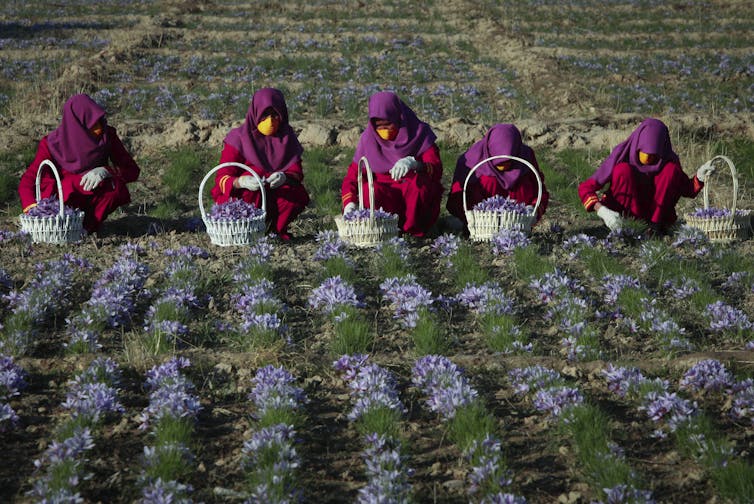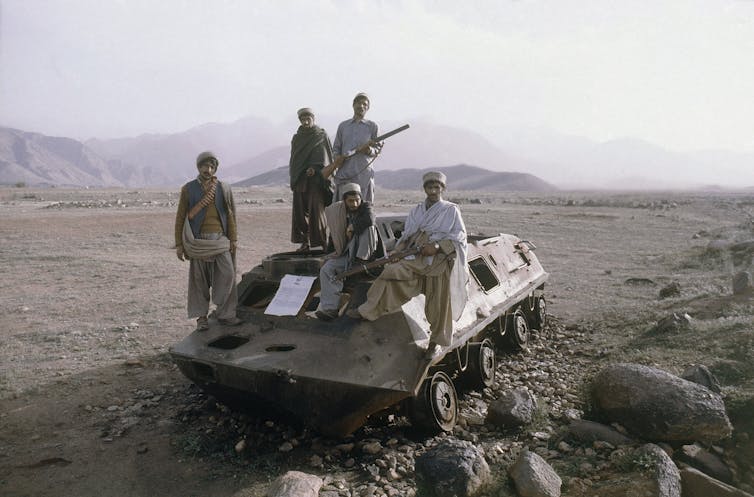Taliban negotiations resume, feeding hope of a peaceful, more prosperous Afghanistan
- Written by Elizabeth B. Hessami, Faculty Lecturer, Johns Hopkins University
Peace talks[1] have resumed[2] between the United States and the Taliban of Afghanistan, three months after negotiations ended abruptly following a deadly Taliban attack[3] in Kabul[4].
The Taliban[5] – an armed insurgency promoting an ultra-conservative form of Sunni Islam – has battled the Afghan government[6] for power for three decades. Since the U.S. invasion of 2001 following the 9/11 World Trade Center attacks, it has also fought the United States.
A new Washington Post report on the 18-year conflict in Afghanistan finds that 2,300 American soldiers and more than 43,000 Afghan citizens[7] were killed in what U.S. officials knew was an “unwinnable war.”
A peace deal with the Taliban would set the terms for a staged withdrawal[8] of the remaining 14,000 U.S. troops from Afghanistan. In exchange, the Taliban must agree to enter talks with Afghan government officials and cut ties[9] with terrorist groups like al-Qaida.
But peace in Afghanistan will take more than an accord. History shows that economic growth[10] and better job opportunities are necessary to rebuild stability after war[11].
Building a lasting peace
Based on my research[12] and teaching on armed conflict, the environment and peacebuilding in Afghanistan, I believe careful and sustainable use of the country’s abundant natural resources[13] could be one path towards recovery.
Insurgent groups recruit people who desperately need an income. As Wired magazine reported back in 2007[14], the Taliban paid its soldiers far better than the Afghan government. Today, salaries for members of ISIS-KP, the Islamic State’s local branch, are reportedly even higher.
Creating well-paid alternatives to extremist groups, then, is a critical piece in solving Afghanistan’s national security puzzle.
And since many fighters for insurgent groups in Afghanistan come from a farming background[15] – and agriculture accounts for 40% of total jobs[16] in Afghanistan – rural development will be particularly important for peacebuilding.
“Strengthening natural resource-related livelihoods can [provide] a future for youth who might otherwise join rebel forces,” says Carl Bruch, president of the Environmental Peacebuilding Association[17], a nonprofit organization that studies the relationship between armed conflict and natural resources.
The United States Agency for International Development, which also funds efforts to build the economy of post-conflict countries like Colombia[18] and Democratic Republic of the Congo[19], sees sustainable economic growth as crucial for a peaceful and prosperous Afghanistan[20].
Figs, saffron and pine nuts
The export market for coveted Afghan agricultural products like cashmere, pine nuts, figs, and saffron is one potentially lucrative sector of the rural economy.
On Nov. 25, several Chinese importers finalized a deal with Afghan companies[21] to buy US $2.2 billion in Afghan pine nuts over the next five years.
Other agricultural exports from Afghanistan are finding their place in the world market, too. Grape sales[22] brought Afghanistan $143 million in 2017. Tropical fruits earned $101 million.
The Afghan government recognizes its potential as a global source of fine foods.
Eight months after Afghan President Ashraf Ghani created several new air corridors in 2018[23] – safe and direct flight paths created for trade and other purposes – exports from Afghanistan increased 32%[24]. These air routes connect Afghanistan to India, Turkey, China, Saudi Arabia, Europe, Russia, China, the United Arab Emirates and Uzbekistan – commercial hubs that give Afghan products access to other trade destinations.
 Afghan women work in a saffron field in Herat, Afghanistan, Nov. 27, 2013.
AP Photo/Hoshang Hashimi, File[25]
Afghan women work in a saffron field in Herat, Afghanistan, Nov. 27, 2013.
AP Photo/Hoshang Hashimi, File[25]
Recently, browsing in a local health food store in Los Angeles, I was surprised to come upon a bright red bag of Kandahar figs.
The distributor, Ziba Foods, told me that 80% of their workforce – both management and staff positions – is female, and that the company provides English lessons and other professional development to staff.
“We are committed to providing our Afghan staff with year-round employment despite the cyclical nature of the agricultural sector,” Ziba partner Raffi Vartanian said.
Emerald mining
Emeralds are another Afghan product with the potential to drive economic growth.
High up in the Hindu Kush mountains of Panjshir Province are buried vivid green emeralds of noted color and purity[26].
The inhabitants of Panjshir once sold these famous emeralds to finance[27] their resistance to Soviet occupation[28]. In a more stable future, these precious stones could provide substantial incomes for people in an area that’s too mountainous for farming or herding.
Afghanistan exported an estimated $100 million in emeralds in 2018, according to InColor Magazine[29], a publication of the International Colored Gemstone Association. In 2015, Christie’s[30] auction house sold an Afghan emerald for $2,276,408[31], a record price for Christie’s[32].
Despite some recent road repairs[33], the mountainous and remote Panjshir region remains extremely difficult to get in and out of[34]. With better access, improved technology and more training for miners[35], analysts estimate Panjshir could produce $300 to $400 million[36] worth of emeralds each year.
Good timing
The U.S.-Taliban peace talks are restarting exactly 40 years after the 1979 Soviet Invasion[37] that triggered the cycle of armed conflict that continues to destabilize this Central Asian nation. An estimated 2.5 million Afghans[38] were killed or wounded during the decadelong Soviet occupation.
The withdrawal of Soviet troops in 1989[39] left the country in chaos, vulnerable to the eventual rise[40] of militant groups like the Taliban, al-Qaida and, eventually, IS-KP.
 Afghan rebels on top of knocked out Russian armored vehicle in Afghanistan in February 1980.
AP Photo[41]
Afghan rebels on top of knocked out Russian armored vehicle in Afghanistan in February 1980.
AP Photo[41]
Though the 27.5 million Afghans under the age of 25[42] have only known war, the population is hopeful about their country’s prospects for peace. A recent survey by the Asia Foundation of 18,000 Afghans[43] found that 90% of those[44] surveyed strongly support efforts towards a deal with the Taliban.
Older Afghans remember happier times in their country. My husband, who left Afghanistan as a young man after the Soviet invasion, has photo albums showing his family grilling kebabs and lounging in the rose-filled Paghman Gardens, just outside the city. Back then, beautiful Kabul was known as “the Paris of Central Asia[45].”
Many of Paghman’s lawns and palaces[46] are now in the process of careful restoration – a hopeful sign after decades of destruction.
In the 1960s and 1970s, Afghanistan’s spectacular natural landscapes attracted thousands of tourists each year, according to the Ministry of Foreign Affairs of Afghanistan[47]. Young travelers who took the famous “Hippy Trail” – a 4,660-mile[48] journey from London to Goa, India – would pass through Afghanistan.
 Visitors in 2009 at at a lake in Band-e-Amir, Afghanistan’s first national park.
AP Photo/Rahmat Gul[49]
Visitors in 2009 at at a lake in Band-e-Amir, Afghanistan’s first national park.
AP Photo/Rahmat Gul[49]
Ecotourism is another industry that could develop in Afghanistan if armed conflict ceases[50].
A Taliban accord is necessary to end the Afghanistan war. But creating meaningful jobs and sustainable economic growth will help create a durable peace[51].
[ Expertise in your inbox. Sign up for The Conversation’s newsletter and get a digest of academic takes on today’s news, every day.[52] ]
References
- ^ Peace talks (www.nytimes.com)
- ^ resumed (www.aljazeera.com)
- ^ Taliban attack (www.bbc.com)
- ^ in Kabul (www.bbc.com)
- ^ Taliban (cisac.fsi.stanford.edu)
- ^ battled the Afghan government (www.nbcnews.com)
- ^ 2,300 American soldiers and more than 43,000 Afghan citizens (www.washingtonpost.com)
- ^ staged withdrawal (www.nytimes.com)
- ^ cut ties (www.nbcnews.com)
- ^ economic growth (www.undp.org)
- ^ rebuild stability after war (books.google.com)
- ^ research (www.researchgate.net)
- ^ abundant natural resources (postconflict.unep.ch)
- ^ Wired magazine reported back in 2007 (www.wired.com)
- ^ farming background (reliefweb.int)
- ^ 40% of total jobs (www.worldbank.org)
- ^ Environmental Peacebuilding Association (environmentalpeacebuilding.org)
- ^ efforts to build the economy of post-conflict countries like Colombia (www.chemonics.com)
- ^ Democratic Republic of the Congo (www.usaid.gov)
- ^ crucial for a peaceful and prosperous Afghanistan (www.usaid.gov)
- ^ companies (www.avapress.com)
- ^ Grape sales (oec.world)
- ^ new air corridors in 2018 (tolonews.com)
- ^ exports from Afghanistan increased 32% (www.themigrantproject.org)
- ^ AP Photo/Hoshang Hashimi, File (www.apimages.com)
- ^ noted color and purity (www.gia.edu)
- ^ to finance (www.npr.org)
- ^ resistance to Soviet occupation (www.npr.org)
- ^ InColor Magazine (www.gemstone.org)
- ^ Christie’s (www.lj24magazine.com)
- ^ $2,276,408 (www.gemstone.org)
- ^ record price for Christie’s (magazine.stregis.com)
- ^ recent road repairs (www.worldbank.org)
- ^ extremely difficult to get in and out of (www.latimes.com)
- ^ more training for miners (money.cnn.com)
- ^ $300 to $400 million (www.gemstone.org)
- ^ 1979 Soviet Invasion (news.bbc.co.uk)
- ^ 2.5 million Afghans (www.latimes.com)
- ^ withdrawal of Soviet troops in 1989 (nsarchive.gwu.edu)
- ^ eventual rise (www.npr.org)
- ^ AP Photo (www.apimages.com)
- ^ under the age of 25 (afghanistan.unfpa.org)
- ^ 18,000 Afghans (heartofasia.af)
- ^ 90% of those (heartofasia.af)
- ^ the Paris of Central Asia (www.nytimes.com)
- ^ Paghman’s lawns and palaces (www.bakhtarnews.com.af)
- ^ according to the Ministry of Foreign Affairs of Afghanistan (www.mfa.gov.af)
- ^ 4,660-mile (www.independent.co.uk)
- ^ AP Photo/Rahmat Gul (www.apimages.com)
- ^ armed conflict ceases (www.cfr.org)
- ^ help create a durable peace (www.usaid.gov)
- ^ Expertise in your inbox. Sign up for The Conversation’s newsletter and get a digest of academic takes on today’s news, every day. (theconversation.com)
Authors: Elizabeth B. Hessami, Faculty Lecturer, Johns Hopkins University



